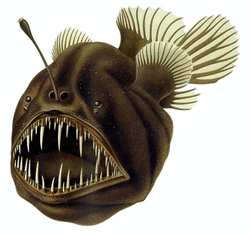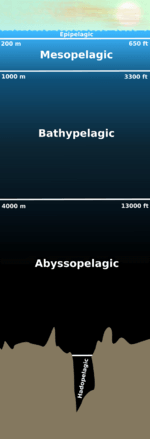Deep sea fish facts for kids
Deep-sea fish are amazing creatures that live in the very deep parts of the ocean, far below where sunlight can reach. This dark, mysterious world is their home.
Contents
Common Deep-Sea Fish
The most common deep-sea fish is the lanternfish. You might also find other cool deep-sea fish like:
- Flashlight fish
- Cookiecutter shark
- Bristlemouths
- Anglerfish
- Viperfish
- Some types of eelpout
Their Ocean Home
Deep-sea fish usually live in ocean layers that are 1,000 to 6,000 meters (about 3,300 to 20,000 feet) deep. No sunlight reaches these areas at all! These deep zones make up about 75% of all the living space in the ocean.
The deep sea is a very tough place to live. Temperatures are usually super cold, often around 3°C (37°F) or even as low as -1.8°C (29°F). The only exceptions are around special spots called hydrothermal vents, where water can be super hot, over 350°C (662°F)! Also, there's not much oxygen, and the pressure is incredibly high. It can be 20 to 1,000 times stronger than the air pressure at the surface.
Think of it this way: for every 10 meters (33 feet) you go down, the pressure increases by the same amount as the air pressure at sea level. But deep-sea creatures don't get squished! Their bodies have the same pressure inside them as the water outside, which helps them survive.
Special Features of Deep-Sea Fish
Deep-sea fish have developed amazing ways to live in their challenging environment.
Eyesight in the Dark
Since there's no natural light, deep-sea fish can't just rely on their eyes to find food, mates, or avoid predators. Many of them are actually blind! Instead, they use other senses, like feeling tiny changes in water pressure or having a super strong sense of smell.
Some deep-sea fish do have eyes, and they are incredible. Their eyes are very large and sensitive, able to spot the tiniest bit of light. They can be up to 100 times more sensitive to light than human eyes! Some deep-sea fish even have many copies of a special protein called rhodopsin, which helps them see in dim light. One fish, the silver spinyfin, has 38 copies of this gene!
Blending In with Color
To hide from predators, many deep-sea fish are very dark. This helps them blend in with their dark surroundings.
Fish that live in the middle depths often use color to hide. Predators that wait to ambush their prey are usually black or red. Since red light doesn't reach the deep sea, being red is just like being black down there – it helps them disappear! Fish that move up and down in the water often have shiny, silvery colors.
Many deep-sea fish also have special light-producing organs called photophores on their bellies. These produce a faint light. If a predator is looking up from below, this light helps the fish blend in with the faint light coming from above, making their silhouette disappear. This trick is called counter-illumination.
Making Their Own Light (Bioluminescence)
Many deep-sea fish can make their own light. This is called bioluminescence. They do this by using special chemicals in their bodies that react with oxygen to produce light.
More than half of all deep-sea fish, and even some shrimp and squid, can glow! About 80% of these creatures have photophores, which are like tiny light bulbs that hold glowing bacteria. Some of these photophores even have lenses, just like our eyes, to make the light brighter or dimmer.
Making light only uses about 1% of a fish's energy, but it's super useful! They use it to:
- Find food and attract prey, like the anglerfish does.
- Mark their territory.
- Talk to each other and find a mate.
- Distract or temporarily blind predators to escape.
Body Structure
The deeper a fish lives, the more jelly-like its body becomes, and its bones are often very light. They have a lot of fat and less bone, which helps them float and reduces their body density. This also means they are usually slower and less agile than fish that live closer to the surface.
What Do Deep-Sea Fish Eat?
Since there's no sunlight in the deep sea, plants can't grow there. This means deep-sea creatures can't eat plants directly. Instead, they rely on something called marine snow.
Marine snow is like a continuous shower of tiny bits of dead plants, animals, and waste that falls from the upper parts of the ocean. It includes dead plankton, tiny organisms called protists, poop, sand, and other dust. These "snowflakes" get bigger as they fall and can take weeks to reach the ocean floor. However, most of this marine snow gets eaten by tiny creatures like microbes and zooplankton before it even reaches 1,000 meters (3,300 feet) deep.
Some deep-sea fish have long feelers to help them find food or mates in the pitch-black ocean. The deep-sea anglerfish, for example, has a special "fishing rod" sticking out of its head. At the end of this rod is a glowing piece of skin that wiggles like a worm to trick other fish into coming closer.
Some deep-sea fish need to eat other fish that are the same size or even bigger than them! They have special features to help them do this, like sharp teeth, jaws that can unhinge, huge mouths, and bodies that can stretch. The gulper eel is a great example of a fish with these amazing adaptations.
Fish that filter tiny particles from the water have small mouths and fine gill structures. Fish that eat other fish have bigger mouths and coarser gill structures.
Daily Travels (Migration)
Most deep-sea fish make daily trips up and down in the water. At night, they swim up to shallower waters to eat tiny animals called zooplankton. Then, during the day, they go back down to the deep for safety. To move up, they use a special organ called a swim bladder. They fill it with gas to float up and let gas out to sink down. As they move up, the pressure changes, so their swim bladder has to adjust to keep them safe. Some of these fish can handle big temperature changes as they move between warm and cold water layers.
Endangered Deep-Sea Fish
Sadly, some deep-sea fish are in danger. A study in 2006 found that five species of deep-sea fish, including the blue hake and spiny eel, are close to extinction. This is happening because fishing boats are now fishing deeper than before, down to 1,600 meters (about 5,200 feet). These fish grow and reproduce very slowly – they become adults around the same age as humans do. This slow reproduction means they can't recover quickly from too much fishing.
Cool Facts About Deep-Sea Fish
- Most deep-sea fish cannot survive if brought to the surface or kept in a lab. They have gas-filled spaces in their bodies. When the pressure changes drastically (like coming to the surface), these gases expand, which can cause the fish to blow up.
- Some deep-sea creatures, like lanternfish, ridgehead, marine hatchetfish, and lightfish, often gather around underwater mountains or slopes.
- During World War II, sonar operators were confused by what looked like a false seafloor about 300–500 meters (1,000–1,600 feet) deep during the day, which moved shallower at night. It turned out to be millions of marine organisms, mostly small deep-sea fish! Their swim bladders reflected the sonar. This phenomenon is now known as the deep scattering layer.
Images for kids
-
Long-snouted lancetfish are ambush predators that live in the middle depths. They can grow up to 2 meters (6.5 feet) long!
See also
 In Spanish: Fauna abisal para niños
In Spanish: Fauna abisal para niños
- Census of Marine Life
- Deep ocean water
- Deep sea
- Deep sea communities
- Deep water fish
- Demersal fish
- Pelagic fish












